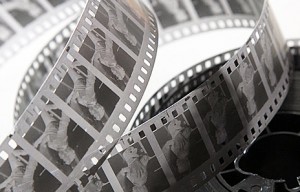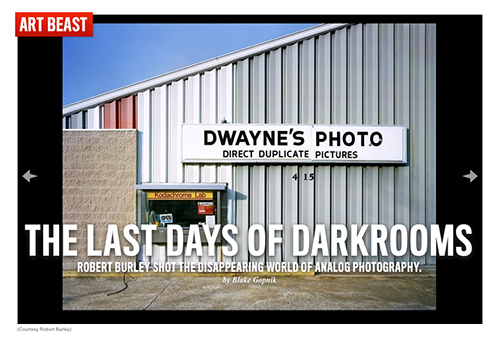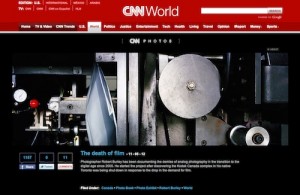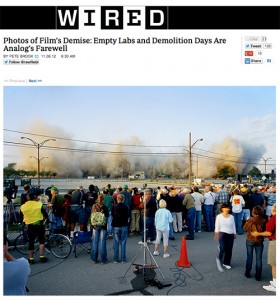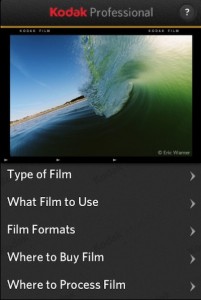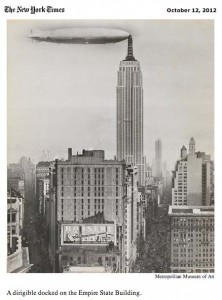Nice article about my project and book by Kirsten Rian in DAYLIGHT blog/magazine
With 35mm film dead….
This article by Daniel Eagan in THE ATLANTIC discusses the analog-to -digital switch in the movie industry. Hollywood is the last domino to fall.
Eagan states: Here’s an indication of how dire the situation has become. The Academy of Motion Picture Arts and Sciences, the organization behind the Oscars, held “the first-ever ‘Film-to-Film’ Festival,” from September 27 to 29. It is an outgrowth of the Academy’s “Project Film-to-Film,” an initiative designed “to take advantage of the current, but threatened, availability of film stock.”
In other words, a film festival celebrating film itself.
Around the world in one day
Over the weekend there have been a number of online features about my book from far and wide. In addition to THE DAILY BEAST (above) there have been features in the following:
The Final Kodak Moment in The Daily Mail – United Kingdom
Un libro documenta la fulminante derrota de la película fotográfica frente a la industria digital – in 20Minutos.es – Spain
The Decline of Film Companies Around the World in NetEase 163.com – China
Fotógrafo registra demolição de fábricas de material fotográfico -http://g1.globo.com/ – Brazil
Filmens siste kapittel – Akam Magazine – Norway
The book is out!
Although Hurricane Sandy slowed things down a bit – the book made it onto the shelves this past week while enjoying recognition online.
Here’s a few places it showed up:
The story continues….
I’ve had a few responses recently commenting on the current status of film and the photographic industry. This fascinating story is still playing itself out and it’s difficult to determine what will happen in the next five years. However, there is a story in the Democrat & Chronicle about a recent podcast by Kodak spokesman Ed Monahan quoted as saying: “While I’d like to say we have seen the worst of it, we’re seeing just the beginning of another onslaught.”
Kodak launches new iPhone app for film …. and the ironies abound.
This past week the Eastman Kodak Company launched a new iPhone app simply called, “Kodak Professional Film”. It’s purpose is to assist photographers that continue to use film with the increasingly difficult task of finding it. Not too long ago, film was a ubiquitous material that could be purchased at any corner store but it has recently become a scarce commodity. Kodak, after declaring bankruptcy in January of this year, dropped another bombshell in August by announcing they would be selling off their film business – a product line which has defined the company since it was established by George Eastman in the late nineteenth century.
The new App allows you to survey Kodak’s current products list which doesn’t take long because there are a total of 8 films: 4 black & white and 4 color. A quick bit of research revealed that Kodak listed 171 “still photographic films” in the early 1970’s. We can see in Robert Shanebrook’s book that as recently as 2009 Kodak was still making 43 brands of film for still cameras. In less than three years their product line has decreased by over 80%. Will this anemic list continue to shrink? I would say yes and predict the next to go are the color films which are being kept afloat by Kodak’s motion picture division. Hollywood still buys billions of feet of film but Kodak has recently made an agreement with four major studios that ends film production by 2015.
This is all to say that I don’t think the Kodak film app is going to do as well as say Instagram – an application that grew into a social networking phenomenon by simulating the look of all those Kodak films for viewing on an iPhone.
The resurrection of Polaroid films
The Impossible Project (IP), a company based in the Netherlands, has recently announced that it will add the infamous 8×10 “peel-apart” instant film to its roster of products as it continues to reintroduce the lost world of Polaroid into the second decade of the 21st century. After it declared bankruptcy in 2008, the Polaroid Corp. announced it would terminate production of its instant films and one executive was rumored to have said, “it will be impossible for anyone else to produce these complex films” – hence one the explanations for the aptly named IP. The IP began to manufacture its first instant films in 2010 and while I have deep admiration for their spunk and initiative, I wonder if that Polaroid executive may have been correct – at least in part. Even though the IP is run by former Polaroid employees using the Polaroid machinery in one of the old Polaroid factories, their products don’t have many similarities to the original Polaroid products. Lack of access to patents, suppliers and to some of the closely guarded Polaroid secrets meant the IP had to reinvent instant film. How do the IP films compare to the real McCoy made be Polaroid just a few years ago? …. not so great. While there are many comparisons to “fine wine” in their marketing material – the IP films fade, are very inconsistent and lack the rigid quality control systems that Edwin Land’s Polaroid Company insisted on for all its products. IP films have been plagued by stability problems to the point that they’ve introduced the “Impossible Dry Age Kit” (only $8.99) to slow down fading caused by humidity. The press images for their new IP 8×10 film show all kinds of manufacturing problems including chemical staining and uneven development. However, while Edwin Land may be rolling in his grave and photographers like myself declare the latest batch of IP wine to be plonk, a new generation of Instagram image-makers happily pay twice the price for half the quality while declaring, “Cool!”. This is not surprising as I think most of them see the IP prints as an intermediate step between the camera and the digital world – usually scanning their images immediately after development. In fact, the IP has also recently introduced a device that allows their customers to copy their digital iPhone images onto IP instant film – super-cool! Indeed, while the IP is working with analog media they recognize their market are digital hipsters. Their attraction to the IP film is precisely because the resulting photographs don’t look like the digital images created on their iPhones. The fact that the IP films are messy, unpredictable and there is no “Control Z” button to push once the image is formed is a big plus in an age of digital banality and homogeneity.
Bravo to IP but I also wonder if this company and its products signal the last chapter in the long history of a ubiquitous 20th century product: film. Once a carefully manufactured material used for numerous applications such art, cinema, reportage, science, etc. – it looks as though film in the 21st century may be reduced to a toy or novelty.
Traveling Exhibition opens at George Eastman House – International Museum of Photography & Film
<
For more information see: EASTMAN HOUSE
Faking it: Manipulated Photography Before Photoshop
Organized by Mia Fineman, an assistant curator in the Metropolitan Museum’s Department of Photography this exhibition looks at manipulated photographs created between 1846 and the early 1990’s (Adobe Photoshop was introduced in 1990). Ms. Fineman has also organized,“After Photoshop: Manipulated Photography in the Digital Age,” which is in one of the other Met galleries.
The exhibition review in the NYTimes raises the inevitable questions about how the manipulated image changes our relationship to photography. Writer Ken Johnson asks, We are left, then, to wonder. If photography cannot capture truth, what is it good for? Leaving aside the ever-increasing use of imaging technology for identification, surveillance, scientific and medical discovery and so on, what is its special purpose as far as art is concerned?
Good questions. I look forward to seeing the exhibition in a couple weeks time.
Kodak seeks to end retiree health benefits
Last week the bankrupt Eastman Kodak Co. filed a motion in U.S. Bankruptcy Court after reaching a deal with the committee representing its 56,000 retirees to end their healthcare benefits by the end of the year. This news has not gone down well in Rochester, NY – the city which Kodak has called home since it was established by George Eastman in 1892. At one time Kodak had 60,000 employees in Rochester: one in every four Rochesterians were employed at Kodak either working in the State Street Head Offices or, more likely, in the sprawling manufacturing complex known as Kodak Park. Before the start of its economic free fall which resulted in a bankruptcy filing in January 2012, Eastman Kodak was a great place to work – offering job security for life and very generous benefits.
Today, Kodak employs less than 5000 workers in Rochester (with more layoffs coming) but there are many more thousands of retired Kodakers living in the city livid about this most recent announcement. Democrat and Chronicle writer, Erika Bryant has just written an article taking aim at CEO Antonio Perez which provides a taste of this anger. However, the comments at the end of Bryant’s article are where the gloves come off. Kodak appears to have become a poster child for “the lost decade” – a time when manufacturing jobs in the West, and the lifestyle that came with – have disappeared. While Kodak is victim of a technological paradigm shift – they have not been replaced by any similar corporations that provide the kind of jobs and compensation which have supported many generations of workers in the US and abroad.


